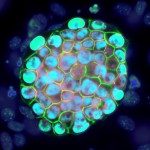Link to Pubmed [PMID] – 22251857
Biol Aujourdhui 2011;205(4):223-33
The production of fertilizable ova is the consequence of multiple events that start as soon as ovarian development and culminate at the time of ovulation. Throughout their development, germ cells are associated with companion somatic cells, which ensure germ cell survival, growth and maturation. Data obtained in vitro and in vivo on several animal models of germ cell depletion have led to uncover the many roles of germ cells on both ovarian development and folliculogenesis. During ovarian development, germ cells become progressively enclosed within epithelial structures called “ovigerous cords” constituted by pregranulosa cells, lined by a basement membrane. At the end of ovarian development, ovigerous cords fragment into primordial follicles, which are epithelial units constituted by an oocyte surrounded by a single layer of granulosa cells. Germ cells are necessary for the fragmentation of ovigerous cords into follicles, since in their absence, no follicle will form. Germ cells also ensure the differentiation of the ovarian somatic lineage, and they may inhibit the testis-differentiating pathway by preventing the conversion of pregranulosa cells into Sertoli cells, their counterpart in the testis. Regularly, primordial follicles are recruited into the growing follicle pool and initiate their growth. They develop through primary, preantral, antral and preovulatory stages before being ovulated. Interestingly, the action of the oocyte on companion somatic cells tightly depends on the follicular stage. In primordial follicles, the oocyte prevents the transdifferentiation of granulosa cells into cells resembling Sertoli cells. By contrast, as soon as the follicle enters growth, the oocyte regulates the functional differentiation of granulosa cells and at the latest stages, it prevents their premature maturation into luteal cells. Overall, these data demonstrate that the female germ cell act on companion somatic cells to regulate ovarian development and folliculogenesis, thereby actively supporting its own maturation.

